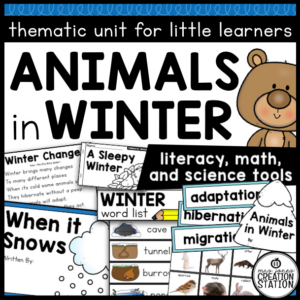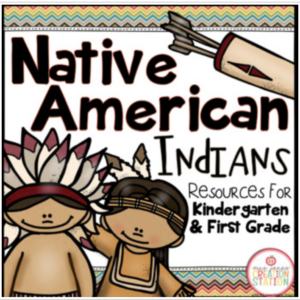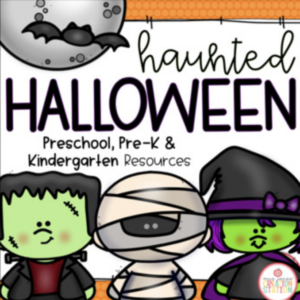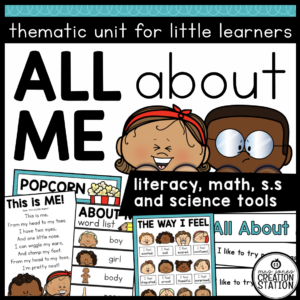Discover all things about oviparous animals with this thematic science unit! Use this resource during the Easter season or any time of the year! Specifically tailored for kindergarten and first-grade learners, this unit seamlessly integrates science and literacy with engaging read aloud options and activities, offering a comprehensive and engaging learning experience.
Buy the BUNDLE and SAVE! You can purchase this resources in the Thematic Activities for Little Learners Bundle and the Little Learners Mega-Bundle!
What’s Included:
- Whole Group Lessons: Dig into learning all about oviparous animals through read aloud options along with science centered activities. This unit includes five whole group lessons. Learn the difference between oviparous and viviparous animals, sort different oviparous animals into categories, learn about where oviparous animals live and so much more!
- Suggested Reading List: An amazing list of picture books about oviparous animals that help introduce the whole group lessons.
- Thematic Reader: Spark a love for reading and enhance literacy skills with our thematic reader. Through simple sentences and illustrations, students will focus on fluency and word recognition skills.
- Interactive Poem: Foster creativity and language development with our interactive poem centered around Oviparous animals. Students will participate in reciting and acting out the poem, reinforcing vocabulary and word recognition.
- Math and Literacy Centers: Reinforce key math and literacy concepts with our engaging centers. From initial sounds to rhyming to addition and subtraction skills, these centers provide hands-on learning experiences that support academic growth and development.
The benefits of this resource:
- Comprehensive Learning: Our unit blends science and literacy seamlessly, ensuring a well-rounded educational experience for young learners.
- Engaging Activities: Hands-on sorting and interactive lessons keep students actively involved, fostering exploration and discovery.
- Conceptual Understanding: Exploring oviparous animal life cycles builds a strong foundation for future science learning.
- Language Development: Integrated picture books and literacy activities enhance vocabulary and comprehension skills.
- Critical Thinking: Students develop problem-solving skills and scientific reasoning through inquiry-based activities.
- Teacher Convenience: Ready-to-use resources save valuable planning time, allowing educators to focus on student engagement and learning.
Other Units You Might Like:
Spring Science Unit
Weather Science Unit
Community Helpers Social Studies Unit
LEARNING STANDARDS INCLUDED IN THIS RESOURCE
Common Core Standards
Language Arts
CCSSL.K.2d
Spell simple words phonetically, drawing on knowledge of sound-letter relationships.
CCSSL.K.4
Determine or clarify the meaning of unknown and multiple-meaning words and phrases based on kindergarten reading and content.
CCSSL.K.5a
Sort common objects into categories (e.g., shapes, foods) to gain a sense of the concepts the categories represent.
CCSSL.K.5c
Identify real-life connections between words and their use (e.g., note places at school that are colorful).
CCSSRF.K.1c
Understand that words are separated by spaces in print.
CCSSRF.K.2a
Recognize and produce rhyming words.
CCSSRF.K.2d
Isolate and pronounce the initial, medial vowel, and final sounds (phonemes) in three-phoneme (consonant-vowel-consonant, or CVC) words. (This does not include CVCs ending with /l/, /r/, or /x/.)
CCSSRF.K.3b
Associate the long and short sounds with common spellings (graphemes) for the five major vowels.
CCSSRI.K.2
With prompting and support, identify the main topic and retell key details of a text.
CCSSW.K.2
Use a combination of drawing, dictating, and writing to compose informative/explanatory texts in which they name what they are writing about and supply some information about the topic.
Math
CCSSK.CC.A.3
Write numbers from 0 to 20. Represent a number of objects with a written numeral 0-20 (with 0 representing a count of no objects).
CCSSK.CC.B.4
Understand the relationship between numbers and quantities; connect counting to cardinality.
CCSSK.CC.B.4a
When counting objects, say the number names in the standard order, pairing each object with one and only one number name and each number name with one and only one object.
CCSSK.CC.B.4b
Understand that the last number name said tells the number of objects counted. The number of objects is the same regardless of their arrangement or the order in which they were counted.
CCSSK.CC.B.5
Count to answer “how many?” questions about as many as 20 things arranged in a line, a rectangular array, or a circle, or as many as 10 things in a scattered configuration; given a number from 1-20, count out that many objects.
CCSSK.G.A.2
Correctly name shapes regardless of their orientations or overall size.
CCSSK.NBT.A.1
Compose and decompose numbers from 11 to 19 into ten ones and some further ones, e.g., by using objects or drawings, and record each composition or decomposition by a drawing or equation (e.g., 18 = 10 + 8); understand that these numbers are composed of ten ones and one, two, three, four, five, six, seven, eight, or nine ones.
CCSSK.OA.A.1
Represent addition and subtraction with objects, fingers, mental images, drawings, sounds (e.g., claps), acting out situations, verbal explanations, expressions, or equations.
CCSSK.OA.A.2
Solve addition and subtraction word problems, and add and subtract within 10, e.g., by using objects or drawings to represent the problem.
Next Generation Science Standards
NGSSK-ESS3-1
Use a model to represent the relationship between the needs of different plants or animals (including humans) and the places they live. Examples of relationships could include that deer eat buds and leaves, therefore, they usually live in forested areas; and, grasses need sunlight so they often grow in meadows. Plants, animals, and their surroundings make up a system.
Texas Essential of Knowledge and Skills
Language Arts
TEKSLA.K.2.A.i
The student develops word structure knowledge through phonological awareness, print concepts, phonics, and morphology to communicate, decode, and spell. The student expects to: demonstrate phonological awareness by: identifying and producing rhyming words.
TEKSLA.K.2.B.i
The student develops word structure knowledge through phonological awareness, print concepts, phonics, and morphology to communicate, decode, and spell. The student expects to: demonstrate and apply phonetic knowledge by: identifying and matching the common sounds that letters represent.
TEKSLA.K.2.B.ii
The student develops word structure knowledge through phonological awareness, print concepts, phonics, and morphology to communicate, decode, and spell. The student expects to: demonstrate and apply phonetic knowledge by: using letter-sound relationships to decode, including VC, CVC, CCVC, and CVCC words.
TEKSLA.K.2.C.i
The student develops word structure knowledge through phonological awareness, print concepts, phonics, and morphology to communicate, decode, and spell. The student expects to: demonstrate and apply spelling knowledge by: spelling words with VC, CVC, and CCVC.
TEKSLA.K.2.C.ii
The student develops word structure knowledge through phonological awareness, print concepts, phonics, and morphology to communicate, decode, and spell. The student expects to: demonstrate and apply spelling knowledge by: spelling words using sound-spelling patterns.
TEKSLA.K.5.B
The student uses metacognitive skills to both develop and deepen comprehension of increasingly complex texts. The student expects to: generate questions about text before, during, and after reading to deepen understanding and gain information with adult assistance.
TEKSLA.K.5.F
The student uses metacognitive skills to both develop and deepen comprehension of increasingly complex texts. The student expects to: make inferences and use evidence to support understanding with adult assistance.
TEKSLA.K.8.D.i
The student recognizes and analyzes genre-specific characteristics, structures, and purposes within and across increasingly complex traditional, contemporary, classical, and diverse texts. The student expects to: recognize characteristics and structures of informational text, including: the central idea and supporting evidence with adult assistance.
Math
TEKSMA.K.2.A
Number and operations. The student applies mathematical process standards to understand how to represent and compare whole numbers, the relative position and magnitude of whole numbers, and relationships within the numeration system. The student expects to: count forward and backward to at least 20 with and without objects.
TEKSMA.K.2.C
Number and operations. The student applies mathematical process standards to understand how to represent and compare whole numbers, the relative position and magnitude of whole numbers, and relationships within the numeration system. The student expects to: count a set of objects up to at least 20 and demonstrate that the last number said tells the number of objects in the set regardless of their arrangement or order.
TEKSMA.K.2.I
Number and operations. The student applies mathematical process standards to understand how to represent and compare whole numbers, the relative position and magnitude of whole numbers, and relationships within the numeration system. The student expects to: compose and decompose numbers up to 10 with objects and pictures.
TEKSMA.K.6.A
Geometry and measurement. The student applies mathematical process standards to analyze attributes of two-dimensional shapes and three-dimensional solids to develop generalizations about their properties. The student expects to: identify two-dimensional shapes, including circles, triangles, rectangles, and squares as special rectangles.
Science
TEKSSCI.K.9.A
Organisms and environments. The student knows that plants and animals have basic needs and depend on the living and nonliving things around them for survival. The student expects to: differentiate between living and nonliving things based upon whether they have basic needs and produce offspring.
TEKSSCI.K.9.B
Organisms and environments. The student knows that plants and animals have basic needs and depend on the living and nonliving things around them for survival. The student expects to: examine evidence that living organisms have basic needs such as food, water, and shelter for animals and air, water, nutrients, sunlight, and space for plants.
CONNECT WITH MJCS
WEBSITE | FACEBOOK | INSTAGRAM | PINTEREST | TEACHERS PAY TEACHERS
© Mrs. Jones’ Creation Station, Inc




